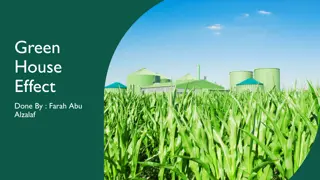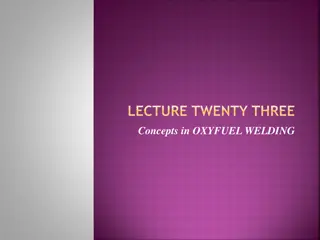Understanding Gases in the Environment and Their Impact on Earth
Gases such as CO, CO2, SO2, O2, and O3 play a crucial role in shaping our environment. This chapter delves into the properties of gases, the three states of matter, pressure exerted by gases, atmospheric pressure measurement methods, and units of pressure used in scientific fields.
Download Presentation

Please find below an Image/Link to download the presentation.
The content on the website is provided AS IS for your information and personal use only. It may not be sold, licensed, or shared on other websites without obtaining consent from the author. Download presentation by click this link. If you encounter any issues during the download, it is possible that the publisher has removed the file from their server.
E N D
Presentation Transcript
Chapter 5 Gases CO, CO2, SO2, O2, O3, . Affecting our life on earth, affecting our Environment We live immersed in a gaseous solution, AIR
(a) One mole of N2(l)has a volume of approximately 35 mL and density of 0.81 g/mL. B) One mole of N2(g) has a volume of 22.4 L (STP) and a density of 1.2 x 10-3 g/mL. Thus the ratio of the volumes of gaseous N2 and liquid N2 is 22.4/0.035 = 640 and the spacing of the molecules is 9 times farther apart in N2(g).
Pressure The pressure exerted by the gases in the atmosphere can be demonstrated by boiling water in a large metal can (a) and then turning off the heat and sealing the can (b).
Measuring Atmospheric Pressure A torricellian barometer. The tube, completely filled with mercury, is inverted in a dish of mercury.
Atmospheric Pressure P = F/A [Pressure is force exerted per unit area] The mass of air pulled by gravity exerts a force on the earth s atmosphere this causes atmospheric pressure A column of air 1 m2 in cross section exerts a force of 105 N. The pressure exerted by air in this case is 100 kPa.
1 m2 column of air 1 atm pressure
Units of Pressure 760 mm Hg = 760 torr = 1 atmosphere = 76 cm Hg = 101.3 kPa where 1 Pa = 1 N/m2 (SI system)
Common Units of Pressure Unit Atmospheric Pressure Scientific Field pascal (Pa); 1.01325 x 105 Pa SI unit; physics, kilopascal(kPa) 101.325 kPa chemistry atmosphere (atm) 1 atm* Chemistry millimeters of mercury 760 mmHg* Chemistry, medicine, ( mm Hg ) biology torr 760 torr* Chemistry pounds per square inch 14.7 lb/in2 Engineering ( psi or lb/in2 ) bar 1.01325 bar chemistry, physics
Manometer: Measuring Gas Pressure
Gas Laws: 1-Boyles Law A J-tube similar to the one used by Boyle.
PV = constant at constant n and temp. 1 = = constant V P
Definition of an ideal gas A gas that obeys Boyle s law is called an ideal gas Real gases approach ideal behavior in the limit of low pressure and high temperature therefore ideal behavior is a limiting behavior (in the limits of high T and low P)
A plot of PV versus P for several gases at pressures below 1 atm.
Charles Law (Jacques Charles 1746-1823) When you heat a hot air balloon it expands. Charles s Law: the volume of a fixed quantity of gas at constant pressure increases as the temperature increases. Mathematically: o ( ) V t C
Charles Law: Plots of V versus t ( C) for several gases. 18
Plots of V versus T on the Kelvin scale. K = oC + 273.15 V=bT(K) -273.15 oC = 0K Absolute Zero Below which V is negative physically impossible 0.000001 K has been produced but not 0 Kelvin
Avogadros Law Avogadro s hypothesis is that equal volumes of gas at the same temperature and pressure contain the same number of molecules Avogadro s Law: the volume of gas at a given temperature and pressure is directly proportional to the number of moles of gas. V n at constant T and P
Mathematically: V = constant n We can show that 22.4 L of any gas at 0 C and 1 atm contain 6.022 1023 gas molecules (1 mole). We define STP (standard temperature and pressure) = 0 C (273.15 K), 1 atm.
Ideal Equation of State 1 = = constant V P V T at constant P and n V n at constant T and P P V n T
Ideal Equation of State PV = nRT R = Universal Gas Constant = 0.08206 L.atm/K.mol P in atm V in L T in K n in mole























